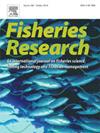近岸水獭拖网渔业中棘角鲨(Squalus acanthias)的生存能力
IF 2.3
2区 农林科学
Q2 FISHERIES
引用次数: 0
摘要
棘角鲨(Squalus acanthias)以前是由欧盟(EU)船只捕捞的,但由于种群状况不佳,渔业于2011年关闭。在收到关于棘鱼种群恢复的积极建议后,渔业于2023年重新开放,促使对管理措施和捕捞后生存进行评估。我们使用状态评估和生存弹出式卫星档案标签(sPATs)评估了近岸底水獭拖网渔业中spurdog的生存能力。我们用五分制(优秀、良好、差、垂死和死亡)对463只样本犬的活力进行了分类。用sPATs标记了20只状态良好、良好和较差的spurdog。奄奄一息的鱼被认为已经死亡。根据能够携带标签的鱼的尺寸、最大保护参考尺寸和状态评估结果,将标签鱼的尺寸限制在80-100 cm的总长度(TL)。观察到的鱼活力为:优9.9% %,良17.3% %,差34.6% %,死鱼38 %,死鱼0.2 %。我们使用Kaplin-Meier估计器来评估标记鱼在30天内的存活率,并估计80至100 cm之间的spurdog的总存活率为78 %。研究结果为加强东北大西洋刺鱼渔业的管理提供了重要的投入。本文章由计算机程序翻译,如有差异,请以英文原文为准。
Survivability of spurdog (Squalus acanthias) in an inshore otter trawl fishery
Spurdog (Squalus acanthias) was previously fished by European Union (EU) vessels, but the fishery closed in 2011 due to poor stock status. Following positive advice on spurdog stock recovery, the fishery reopened in 2023 prompting assessments of management measures and post-capture survival. We assessed spurdog survivability in an inshore bottom otter trawl fishery using condition assessments and survivorship pop-up satellite archival tags (sPATs). We used a five-point scale (excellent, good, poor, moribund and dead) to categorise vitality of 463 sampled spurdog. Twenty spurdog in excellent, good and poor condition were tagged with sPATs. Moribund fish were assumed to have died. Tagged fish size was restricted to 80–100 cm total length (TL) in line with the size of fish capable of carrying tags, the maximum conservation reference size and condition assessments results. The observed fish vitalities were: 9.9 % excellent, 17.3 % good, 34.6 % poor, 38 % moribund and 0.2 % dead. We used a Kaplin-Meier estimator to assess survival of tagged fish over a 30-day period and estimated an overall survival rate of 78 % for spurdog between 80 and 100 cm. Study results provide important input towards enhanced management of spurdog fisheries in the North-East Atlantic.
求助全文
通过发布文献求助,成功后即可免费获取论文全文。
去求助
来源期刊

Fisheries Research
农林科学-渔业
CiteScore
4.50
自引率
16.70%
发文量
294
审稿时长
15 weeks
期刊介绍:
This journal provides an international forum for the publication of papers in the areas of fisheries science, fishing technology, fisheries management and relevant socio-economics. The scope covers fisheries in salt, brackish and freshwater systems, and all aspects of associated ecology, environmental aspects of fisheries, and economics. Both theoretical and practical papers are acceptable, including laboratory and field experimental studies relevant to fisheries. Papers on the conservation of exploitable living resources are welcome. Review and Viewpoint articles are also published. As the specified areas inevitably impinge on and interrelate with each other, the approach of the journal is multidisciplinary, and authors are encouraged to emphasise the relevance of their own work to that of other disciplines. The journal is intended for fisheries scientists, biological oceanographers, gear technologists, economists, managers, administrators, policy makers and legislators.
 求助内容:
求助内容: 应助结果提醒方式:
应助结果提醒方式:


